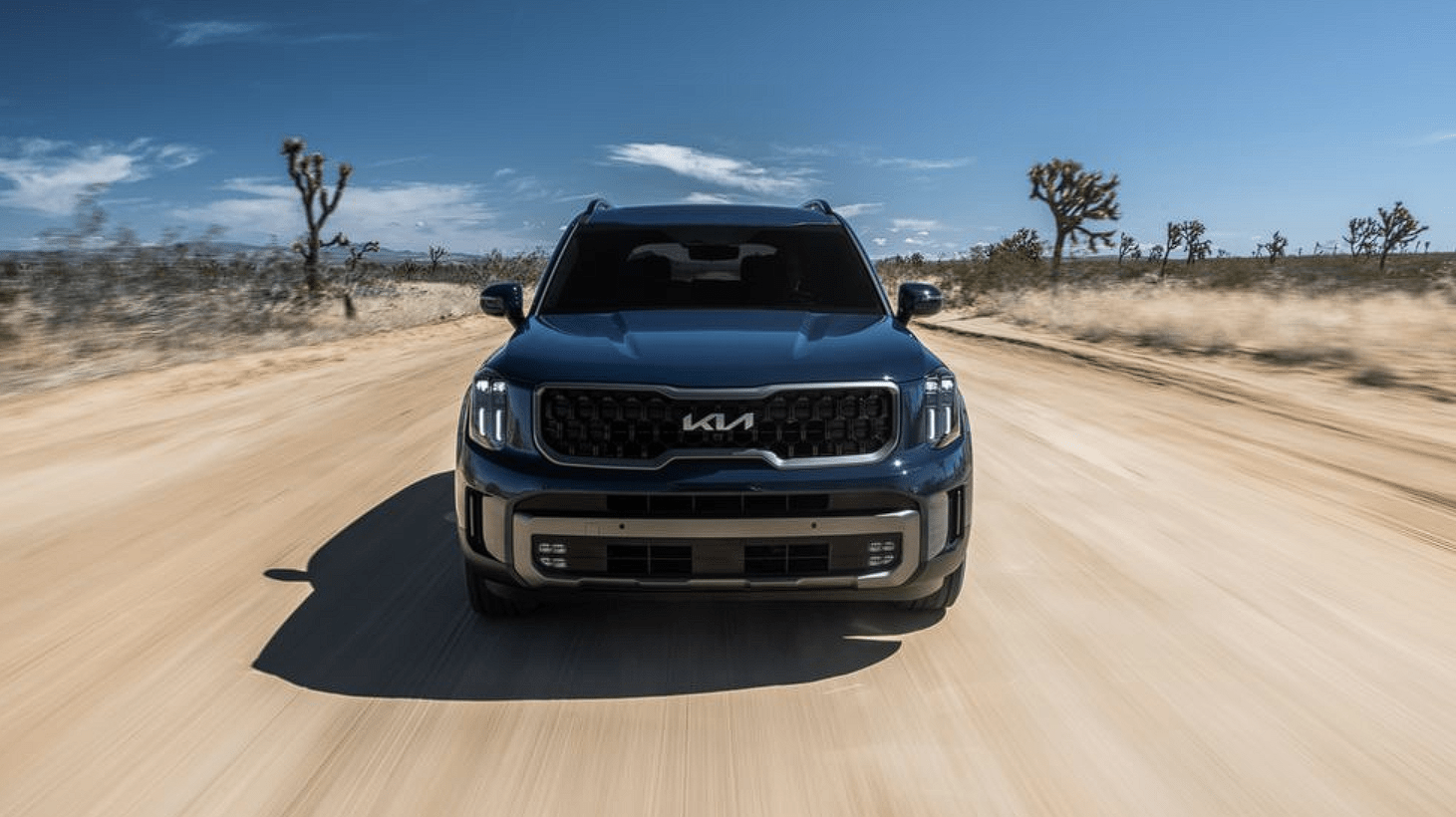Kia Telluride 2023 Armrest (2nd Row Seat), Folding the Rear Seat and Seat Belts
When it comes to comfort, flexibility, and passenger safety, the 2023 Kia Telluride’s Armrest, Rear Seat, and Seat Belts are three important parts that work together to make the ride in this great midsize SUV nothing short of perfect. The armrest was carefully thought out to make things easier for both the driver and the passengers. It’s a great place to relax while driving. In addition, the rear seat is large and can be set up in a variety of ways, so it can easily fit up to five people or turn into a cargo-hauling marvel when needed. The seat belts, on the other hand, are always there to protect passengers, thanks to their adjustable features and improved safety improvements. This in-depth look at the 2023 Kia Telluride’s Armrest, Rear Seat, and Seat Belts shows their many functions, comfort-focused designs, and top-notch safety they provide on every trip, making the Telluride the perfect vehicle for families and people who love adventures.
2023 Kia Telluride Specs, Price, Features and Mileage (Brochure)
Armrest (2nd row seat)
The 2nd-row seats have the armrest located on the side of the seatback.
- To use the armrest, swing down the armrest to the lowest position. Then, adjust the armrest to the desired position while raising it. When adjusting the position, the operating sound will be heard. This indicates normal operation, not malfunction.

For 8 seats
- To use the armrest, pull it forward from the seatback.

Folding the rear seat
The rear seatbacks may be folded to facilitate carrying long items or to increase the luggage capacity of the vehicle.
WARNING
Folded Seatback
The purpose of the fold-down rear seat-backs is to allow you to carry longer objects that could not otherwise be accommodated.
- Never allow a passenger to sit on top of the folded-down seatback while the car is moving. This is not a proper seating position since no seat belts are available for use. This could result in serious injury or death in case of an accident or sudden stop.
WARNING
When folding the seatback, be sure to hold the seatback or headrest with your hands.
CAUTION
When folding or unfolding a rear seat, make sure to lower the seat’s headrest as much as possible and put the seat-back of the seat in front of the rear seat in the upright position.
If there is any interference when folding or unfolding the seat, the interfered area of the seat may be damaged.
Folding down the rear seatback
- Set the front seatback to the upright position and if necessary, slide the front seat forward.
- Lower the rear headrests to the lowest position.
WARNING
Objects
Objects carried on the folded-down seat-back should not extend higher than the top of the front seatback. This could allow cargo to slide forward and cause injury or damage during sudden stops.
CAUTION
When the seats in the 2nd-row are folded to use the area as a cargo compartment, be sure to turn off the seat heater. (if equipped)
- When folding the seatback, insert the rear seat belt buckle in the pocket between the rear seatback and cushion. Make sure both seat belts do not interfere with stowed luggage and cargo. Then, the seat belt webbing should be placed in the webbing guide to prevent the seat belt from being damaged by loaded cargo, etc. If the seat belt is loose, it may cause damage or noise. In that case, return the seatback to the upright position and put the webbing out from the guide to realign it.
- Pull on the seatback folding lever (for 2nd row) or strap (for 3rd row), then fold the seat toward the front of the vehicle. When you return the seatback to its upright position, always be sure it has locked into position by pushing on the top of the seatback.
2nd-row seat * There is no center seat on rear 2nd row for a vehicle with 7 seats.
* There is no center seat on rear 2nd row for a vehicle with 7 seats.
3rd-row seat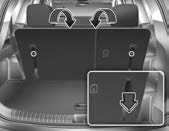
- To use the rear seat, lift and pull the seatback backwards by pulling on the folding lever (for 2nd row) or strap (for 3rd row). Pull the seatback firmly until it clicks into place. Make sure the seatback is locked in place.
- Return the rear seat belt to the proper position.
Unfolding the rear seat
2nd row seat

- * There is no center seat on rear 2nd row for a vehicle with 7 seats.
3rd row seat

- To use the rear seat, lift and pull the seat back backwards. Pull the seatback firmly until it clicks into place. Make sure the seatback is locked in place. When you return the seatback to its upright position, always be sure it has locked into position by pushing on the top of the seatback. If you cannot see the red line at the bottom of folding lever, it means the seatback is locked completely.
- Return the rear seat belt to the proper position.
- When the seatback is completely installed, check the seatback folding lever again.
Folding 2nd-row seat remotely

This feature allows you to fold seats in the 2nd row while the liftgate is open.
- Press the folding switch of the seat-back located on the left and right sides of the liftgate.
- L: Folding the left seat in the 2ndrow
- R: Folding the right seat in the 2nd- row
- You can use additional space by folding the seatback forward.
- If the seatback is not fully folded, try folding again to make it completely folded.
WARNING
Rear seat folding
Do not fold the rear seats (2nd & 3rd row seats), if passengers, pets or luggage are in the rear seats. It may cause injury or damage to passengers, pets, and luggage.
Walk-in seat (2nd row seat)
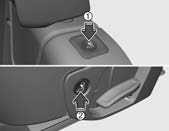
To get in or out from the 3rd-row seat:
- Push the walk-in switch (1, 2) on the 2nd-row seat when the passenger gets in or out from 3rd-row seat.
- After getting in or out, push the 2nd-row seat to the original position until it clicks into place. Make sure that the seat is locked in place.
WARNING
Never attempt to adjust using the 2nd-row seat walk-in switch or strap while the vehicle is moving or seat is occupied as the seat may suddenly move and cause the passenger on the seat to be injured.
7 seat

8 seat
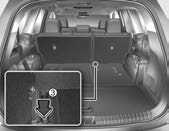
- If the walk-in switch (1 or 2) in the 2nd row (in the upper part of the 2nd-row seatback or the outer part of the seat) does not work, pull the strap (3) on the bottom left of the seat in the 2nd row. It works just like the walk-in switch and you can move the seat forward along with the seatback.
WARNING
Do not pull the strap (3) when the 2nd-row seat(s) is/are occupied.
Sudden movement of the seat(s) may result in injury. Use the strap only when the folding switch in the 2nd row (in the upper part of the second-row seatback or the outer part of the seat) does not work.
- This strap (3) is for 3rd row passengers to exit the vehicle even if when the vehicle’s battery power is in run-out emergency condition in an accident.
WARNING
Uprighting seat
When you return the seatback to its upright position, hold the seatback and return it slowly. If the seatback is returned without holding it, the back of the seat could spring forward, resulting in injury caused by being struck by the seatback.
WARNING
Rear seatback
To ensure maximum protection in the event of an accident or sudden stop, when returning the rear seat to the upright position:
- Be careful not to damage the seat belt webbing or buckle.
- Do not allow the seat belt webbing or buckle to become pinched or caught in the rear seat.
- Ensure the seatback is completely locked into its upright position by pushing on the top of the seatback.
Failure to adhere to any of these instructions could result in serious injury or death in the event of a crash.
CAUTION
Damaging rear seat belt buckles
When you fold the rear seatback, insert the buckle between the rear seatback and cushion. Doing so can prevent the buckle from being damaged by the rear seatback.
CAUTION
Rear seat belts
When returning the rear seatbacks to the upright position, remember to return the rear shoulder belts to their proper position.
WARNING
Unless the driver’s position is properly set according to the driver’s physical figure, do not fold the rear seat. It may increase bodily injuries in a sudden stop or collision.
CAUTION
Be careful when loading cargo through the rear passenger seats to prevent damage to the vehicle interior.
WARNING
Cargo
Cargo should always be secured to prevent it from being thrown about the vehicle in a collision and causing injury to the vehicle occupants. Do not place objects in the rear seats, since they can-not be properly secured and may hit the front seat occupants in a collision.
Cargo loading
Make sure the engine is off, the transmission is in P (Park) and the parking brake is securely applied whenever loading or unloading cargo. Failure to take these steps may allow the vehicle to move if the shift lever is inadvertently moved to another position.
Seat belts
Seat belts are designed to bear upon the bony structure of the body, and should be worn low across the front of the pelvis, chest and shoulders.
Seat belt restraint system
For maximum restraint system protection, the seat belts must always be used whenever the vehicle is moving.
- A properly positioned shoulder belt should be positioned midway over your shoulder across your collarbone.
- Never allow children to ride in the front passenger seat. See “Child Restraint System (CRS)” on page 3-31 for further discussion.
WARNING
Twisted seat belt
Make sure your seat belt is not twisted when worn. A twisted seat belt may not properly protect you in an accident and could even cut into your body.
WARNING
Shoulder Belt
- Never wear the shoulder belt under your arm or behind your back. An improperly positioned shoulder belt cannot protect the occupant in a crash.
- Always wear both the shoulder portion and lap portion of the lap/shoulder belt.
WARNING
Damaged seat belt
Any damage in webbing or hardware may lead to serious injury or death in a crash. For your safety, replace the entire seat belt assembly when any part of the webbing or hardware is damaged.
Seat belts are designed to bear upon the bony structure of the body, and should be worn low across the front of the pelvis, chest and shoulders, as applicable; wearing the lap section of the belt across the abdominal area must be avoided.
Seat belts should be adjusted as firmly as possible, consistent with comfort, to provide the protection for which they have been designed.
A slack belt will greatly reduce the protection afforded to the wearer.
Care should be taken to avoid contamination of the webbing with polishes, oils and chemicals, and particularly battery acid. Cleaning may safely be carried out using mild soap and water. The belt should be replaced if the webbing becomes frayed, contaminated or damaged.
- No modifications or additions should be made by the user which would either prevent the seat belt adjusting devices from operating to remove slack, or prevent the seat belt assembly from being adjusted to remove slack.
- When you fasten the seat belt, be careful not to latch the seat belt in the buckles of other seats. It is very dangerous and you may not be protected by the seat belt properly.
- Do not unfasten the seat belt and do not fasten and unfasten the seat belt repeatedly while driving. This could result in loss of control, and an accident causing death, serious injury, or property damage.
- When fastening the seat belt, make sure that the seat belt does not pass over objects that are hard or can break easily.
WARNING
Seat belt buckle
Do not allow foreign material (gum, crumbs, coins, liquids, etc.) to obstruct the seat belt buckle. This may prevent the seat belt from fastening securely.
Driver’s seat belt warning
As a reminder to the driver, the driver’s seat belt warning lights will appear for approximately 6 seconds each time you turn the ENGINE START/STOP button ON regardless of belt fastening. If the seatbelt is not fastened, the warning chime will sound for about 6 seconds.
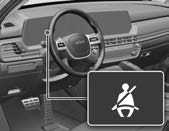
If you start to drive without the seat belt fastened or you unfasten the seat belt when you drive over 5 mph (9 km/h) and less than 12 mph (20 km/h), the corresponding warning light will appear. The Safety warning light will turn off when the vehicle speed drops below 5 mph (9 km/h).
If you start to drive without the seat belt fastened or you unfasten the seat belt when you drive 12 mph (20 km/h) and faster, the warning light will blink and a warning chime will sound for approximately 100 seconds. When the seat belt is unfastened during driving, the warning light will appear when the speed is under 12 mph (20 km/h). When the speed is 12 mph (20 km/h) and faster, the warning light will blink and a warning chime will sound for approximately 100 seconds.
Front passenger’s seat belt warning
As a reminder to the front passenger, the front passenger’s seat belt warning lights will appear for approximately 6 seconds each time you turn the ENGINE START/STOP button ON regardless of belt fastening. If you start to drive without the passenger seat belt fastened or the passenger unfastens the seat belt when you drive over 5 mph (9 km/h) and less than 12 mph (20 km/h), the corresponding warning light will appear. The warning light will turn off when the vehicle speed drops below 5 mph (9 km/h).
If you start to drive without the passenger seat belt fastened or you unfasten the seat belt when you drive 12 mph (20 km/h) and faster, the warning light will blink and warning chime will sound for approximately 100 seconds. When the passenger seat belt is unfastened during driving, the warning light will appear when the speed is under 12 mph (20 km/h). When the speed is 12 mph (20 km/h) and faster, the warning light will blink and a warning chime will sound for approximately 100 seconds.
NOTICE
- Even if the front passenger seat is not occupied, the seat belt warning light will appear for 6 seconds.
- The front passenger’s seat belt warning may operate when luggage is placed on the front passenger seat.
Rear passenger’s seat belt warning

- * 2nd row seat: (1) Left side, (2) Center, (3) Right side
* 3rd row seat: (4) Left side, (5) Center, (6) Right side
* There is no center seat on rear 2nd row for a vehicle with 7 seats. - As a reminder to the rear passenger, the rear passenger’s seat belt warning lights will appear for approximately 6 seconds each time you turn the ignition switch ON regardless of belt fastening.
- If you start to drive without the seat belt fastened, the seat belt warning light will blink for approximately 70 seconds.
- If you unfasten the seat belt when you drive under 20 km/h, the seat belt warning light will blink for approximately 70 seconds.
- If you unfasten the seat belt when you drive over 20 km/h, the seat belt warning chime will sound for approximately 35 seconds and the corresponding warning light will blink.
- If the rear door is opened or closed under 10 km/h, the warning light and warning sound does not work even if driving over 20 km/h.
Seat belt – Driver’s 3-point system with emergency locking retractor
The following explains how to fasten and adjust the driver’s seat belt.
Fastening your seat belt:

- Pull it out of the retractor and insert the metal tab (1) into the buckle (2). There will be an audible “click” when the tab locks into the buckle.

WARNING
You should place the lap belt portion as low as possible and snugly across your hips. If the lap belt is located too high on your waist, it may increase the chance of injury in the event of a collision.
The arm closest to the seat belt buckle should be over the belt while the other arm should be under the belt as shown in the illustration. Never wear the seat belt under the arm closest to the door.
The seat belt automatically adjusts to the proper length only after the lap belt portion is adjusted manually so that it fits snugly around your hips. If you lean forward in a slow, easy motion, the belt will extend and let you move around. If there is a sudden stop or impact, however, the belt will lock into position. It will also lock if you try to lean forward too quickly.
NOTICE
If you are not able to pull out the seat belt from the retractor, firmly pull the belt out and release it. Then you will be able to pull the belt out smoothly.
2023 Kia Telluride Specs, Price, Features, Milage (brochure)
Adjusting the height of the shoulder belt
You can adjust the height of the shoulder belt anchor to one of the 4 positions for maximum comfort and safety.

The height of the adjusting seat belt should not be too close to your neck. The shoulder portion should be adjusted so that it lies across your chest and mid-way over your shoulder near the door and not your neck.
To adjust the height of the seat belt anchor, lower or raise the height adjuster into an appropriate position.
- To raise the height adjuster, pull it up (1).
- To lower it, push it down (3) while pressing the height adjuster button (2). Release the button to lock the anchor into position. Try sliding the height vehicle adjuster to make sure that it has locked into position. Improperly positioned seat belts can cause serious injuries in an accident.
WARNING
Shoulder belt positioning
Verify the shoulder belt anchor is locked into position at the appropriate height. Never position the shoulder belt across your neck or face. Improperly positioned seat belts can cause serious injuries in an accident.
WARNING
Seat belt replacement
After a collision, the seat belt system should be inspected to ensure it is operating normally. Replace any belts that are not functioning appropriately.
Seat belts – Front passenger and rear seat 3-point system with combination locking retractor
The following explains how to fasten the passenger’s and rear seat belt.
Fastening your seat belt:
Combination retractor-type seat belts are installed in the rear seat positions to help accommodate the installation of Child Restraint System. Although a combination retractor is also installed in the front passenger seat position, it is strongly recommended that children always be seated in the rear seat. NEVER place any infant restraint system in the front seat of the vehicle.
This type of seat belt combines the features of both an emergency locking retractor seat belt and an automatic locking retractor seat belt.
- Pull it out of the retractor and insert the metal tab into the buckle. There will be an audible “click” when the tab locks into the buckle. When not securing a child restraint, the seat belt operates in the same way as the driver’s seat belt (emergency locking retractor type).
It automatically adjusts to the proper length only after the lap belt portion of the seat belt is adjusted manually so that it fits snugly around your hips.
When the seat belt is fully extended from the retractor to allow the installation of a Child Restraint System, the seat belt operation changes to allow the belt to retract, but not to extend (automatic locking retractor type). Refer to “Securing a child restraint with a lap/shoulder belt” on page 3-38.
NOTICE
Although the combination retractor provides the same level of protection for seated passengers in either emergency or automatic locking modes, have the seated passengers use the emergency locking feature for improved convenience. The automatic locking function is intended to facilitate child restraint installation. To convert from the automatic locking feature to the emergency locking operation mode, allow the unbuckled seat belt to fully retract.
CAUTION
Do NOT fold down the left portion of the rear seatback when the rear centre seat belt is buckled. ALWAYS UNBUCKLE the rear centre seat belt before folding down the left portion of the rear seatback. If the rear center seat belt is buckled when the left portion of the rear seatback is folded down, distortion and damage to the top portion of the seatback and seat belt garnish may result, causing the seatback to lock into the folded down position.
The seat belt should be locked into the buckle on each seat cushion to be properly fastened.
2nd row seat

* There is no center seat on rear 2nd row for a vehicle with 7 seats.
2nd row seat (8 seats)

- Rear right seat belt fastening buckle
- Rear centre seat belt fastening buckle
- Rear left seat belt fastening buckle
WARNING
Prior to fastening the rear seat belts, ensure the latch matches the seat belt buckle. Forcefully fastening the left or right seat belt to the center buckle can result in an improper fastening scenario that will not protect you in an accident. When using the rear center seat belt, the buckle with the “CENTER” mark must be used.
2nd row seat

3rd row seat

Stowing the rear seat belt
The rear seat belt buckles can be stowed in the pocket between the rear seatback and cushion when not in use.
2nd row seat

* There is no center seat on rear 2nd row for vehicle with 7 seats.
3rd row seat

- Route the seat belt webbing through the rear seat belt guides. It will help keep the belts from being trapped behind or under the seats.
2nd row seat 3rd-row seat
3rd-row seat
- After inserting the seat belt, tighten the belt webbing by pulling it up.
CAUTION
When pulling out to wear the seat belt, the tongue should be slowly pulled out of the seat belt guide so that the seat belt guide does not come off the trim.
Releasing the seat belt:

- The seat belt is released by pressing the release button (1) on the locking buckle. When it is released, the belt should automatically draw back into the retractor.
If this does not happen, check the belt to make sure it is not twisted, then try again.
Rear centre seat belt (3rd row)
To fasten your seatbelt:
- Extract the tongue plate (A) from the hole on the belt assembly cover.

- Insert the tongue plate (A) into the buckle (A’) until an audible “click” is heard, indicating the latch is locked. Make sure the belt is not twisted.

- Pull out the tongue plate (B) from the pocket. Pull the tongue plate (B) and insert it into the buckle (B’) until an audible “click” is heard, indicating the latch is locked. Make sure the belt is not twisted.
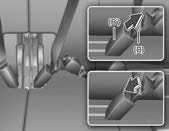
When using the rear center seat belt, the buckle with the “CENTER” mark must be used.
NOTICE
If you are not able to pull out the safety belt from the retractor, firmly pull the belt out and release it. After release, you will be able to pull the belt out smoothly.
To release your seatbelt:
- Press the release button on the buckle (B’) and remove the tongue plate (B).

- To retract the rear centre seatbelt, insert the tongue plate into the web release hole (A’ ). Pull up on the seat belt web and allow the webbing to retract automatically. Insert the tongue plate (A) into the hole on the belt assembly cover.

WARNING
3rd center seat belt

Do not separate the mini tongue (1) and mini buckle (2) even if there is not an occupant. If it is separated, It may hit the rear seat occupants in a collision or sudden stops.
Pre-tensioner seat belt

Your vehicle is equipped with pre-tensioner seat belts at the front and rear outboard seating positions. 1 Retractor pre-tensioner The purpose of the pre-tensioner is to make sure that the seat belts fit tightly against the occupant’s body in certain collisions. The pre-tensioner seat belts may be activated in a collision when the collision is severe enough.
When the vehicle stops suddenly, or if the occupant tries to lean forward too quickly, the seat belt retractor will lock into position. In certain frontal collisions, the pre-tensioner will activate and pull the seat belt into tighter contact against the occupant’s body If the system senses excessive tension on the driver or passenger’s seat belt when the pre-tensioner activates, the load limiter inside the pre-tensioner will release some of the pressure on the affected seat belt. (if equipped)
WARNING
For your safety, be sure that the belt webbing is not loose or twisted and always sit properly on your seat.
NOTICE
The pre-tensioner may activate not only in a frontal collision but also in a side collision if the vehicle is equipped with a side or curtain airbag.\


The seat belt pre-tensioner system consists mainly of the following components. Their locations are shown in the illustration:
- Supplemental Restraint System (SRS) air bag warning light
- Retractor pre-tensioner assembly
- SRS Control Module
- Rear Retractor pre-tensioner
WARNING
For optimal usage of pre-tensioner seat belt:
- The seatbelt must be working correctly and adjusted to the proper position. Please read and follow all of the important information and precautions about your vehicle’s safety features – including seat belts and airbags – that are provided in this manual.
- Be sure you and your passengers always wear seat belts properly. occupant
NOTICE
- When the pre-tensioner seat belts are activated, a loud noise may be heard and fine dust, which may appear to be smoke, may be visible in the passenger compartment. These are normal operating conditions and are not hazardous.
- Although it is harmless, the fine dust may cause skin irritation and should not be breathed for prolonged periods. Wash all exposed skin areas thoroughly after an accident in which the pre-tensioner seat belts were activated.
- Because the sensor that activates the SRS air bag is connected with the pre-tensioner seat belt, the SRS air bag warning light on the instrument panel will appear for approximately 6 seconds after the ENGINE START/STOP button has been turned to the “ON” position, and then it should turn off.
CAUTION
If the pre-tensioner seat belt is not working properly, the SRS airbag warning light will appear even if there is no malfunction of the SRS air bag. If the SRS airbag warning light does not appear when the ENGINE START/STOP button is turned to ON, or if it remains illuminated after appearing for approximately 6 seconds, or if it appears while the vehicle is being driven, have the system inspected by an authorized Kia dealer.
WARNING
- Pre-tensioner seat belts systems are designed to operate only one time. After activation, pre-tensioner seat belts must be replaced. All seat belts of any type should always be replaced after they have been worn during a collision.
- The pre-tensioner seat belt assembly mechanisms become hot during activation. Do not touch the pre-tensioner seat belt assemblies for several minutes after they have been activated.
- Do not attempt to inspect or replace the pre-tensioner seat belts yourself. Have the system inspected by an authorized Kia dealer.
- Do not attempt to service or repair the pre-tensioner seat belt system in any manner.
- Improper handling of the pre-tensioner seat belt assemblies, and failure to heed the warnings not to strike, modify, inspect, replace, service or repair the pre-tensioner seat belt assemblies may lead to improper operation or inadvertent activation and serious injury.
- Always wear seat belts when driving or riding in a motor vehicle.
- If the vehicle or pre-tensioner seat belt must be discarded, contact a professional workshop. Visit an authorized Kia dealer.
- Bodywork on the front area of the vehicle may damage the pre-tensioner seat belt system. Therefore, have the system serviced by an authorized Kia dealer.
NOTICE
Small children are best protected from injury in an accident when properly restrained in the rear seat by a Child Restraint System that meets the requirements of the Federal Motor Vehicle Safety Standards (FMVSS). Before buying any Child Restraint System, make sure that it has label certifying that it meets Federal Motor Vehicle Safety Standard 213. The restraint must be appropriate for your child’s height and weight. Check the label on the child restraint for this information. Refer to
“Child Restraint System (CRS)” on page 3-31.
Larger children
Children who are too large for Child Restraint System should always occupy the rear seat and use the available lap/shoulder belts. The lap portion should be fastened and snug on the hips as low as possible. Check periodically to ensure that the belt fits. A child’s squirming could put the belt out of position. Children are given the most safety in the event of an accident when they are restrained by a proper restraint system in the rear seat. If a larger child (over age
13) must be seated in the front seat, the child should be securely restrained by the available lap/shoulder belt and the seat should be placed in the rearmost position. Children age 13 and under should be restrained securely in the rear seat. NEVER place a child age 13 and under in the front seat. NEVER place a rear-facing child seat in the front seat of a vehicle.
If the shoulder belt portion slightly touches the child’s neck or face, try placing the child closer to the center of the vehicle. If the shoulder belt still touches their face or neck they need to be returned to a Child Restraint System.
WARNING
Small children
Do not allow small children to ride in the vehicle without an appropriate Child Restraint System. If the shoulder belt comes in contact with your child’s neck or face your child is too small to ride in the vehicle. In a crash the seat belt will inflict injury to your child’s neck, throat and face.
Restraint of pregnant women
Pregnant women should wear lap/shoulder belt assemblies whenever possible according to specific recommendations by their doctors. The lap portion of the belt should be worn AS SECURELY AND LOW AS POSSIBLE.
WARNING
Pregnant women
Pregnant women must never place the lap portion of the seat belt above or on the abdomen where the fetus is located. The force of the seat belt during a collision will crush the fetus.
Injured person
A seat belt should be used when an injured person is being transported. When this is necessary, you should consult a physician for recommendations.
One person per belt
Two people (including children) should never attempt to use a single seat belt. This could increase the severity of injuries in case of an accident.
Do not lie down
To reduce the chance of injuries in the event of an accident and to achieve maximum effectiveness of the restraint system, all passengers should be sitting up and the front and rear seats should be in an upright position when the vehicle is moving. A seat belt cannot provide proper protection if the person is lying down in the rear seat or if the front and rear seats are in a reclined position.
Care of seat belts
Seat belt systems should never be disassembled or modified. In addition, care should be taken to assure that seat belts and belt hardware are not damaged by seat hinges, doors or other abuse.
WARNING
Pinched seat belt
Make sure that the webbing and/or buckle do not get caught or pinched in the rear seat when returning the rear seat back to its upright position. A caught or pinched webbing/buckle may become damaged and could fail during a collision or sudden stop.
WARNING
Seatbelts can become hot in a vehicle that has been closed up in sunny weather. They could burn infants and children.
Periodic inspection
All seat belts should be inspected periodically for wear or damage of any kind. Any damaged parts should be replaced as soon as possible.
Keep belts clean and dry
Seat belts should be kept clean and dry. If belts become dirty, they can be cleaned by using a mild soap solution and warm water. Bleach, dye, strong detergents or abrasives should not be used because they may damage and weaken the fabric.
When to replace seat belts
The entire in-use seat belt assembly or assemblies should be replaced if the vehicle has been involved in an accident. This should be done even if no damage is visible. Additional questions concerning seat belt operation should be directed to an authorized Kia dealer.
FAQ
A: The armrest in the Telluride typically provides a comfortable place for the driver and passengers to rest their arms during the journey.
A: Some Telluride models may have an adjustable armrest, allowing passengers to customize its height or position.
A: The armrest in the Telluride is usually stationary and not designed to be folded up for additional seating space.
A: The Telluride typically offers a second-row bench seat that can accommodate up to three passengers and a third-row bench seat that can accommodate up to two passengers.
A: Yes, the rear seats in the Telluride are typically foldable to create additional cargo space when needed.
A: Some Telluride models may offer a 60/40 split-folding feature in the second-row bench seat, allowing for versatility in configuring passenger and cargo space.
A: Yes, the Telluride typically includes cupholders and storage options in the rear seat area to enhance passenger convenience.
A: Some Telluride trims may offer rear-seat climate control options, allowing rear passengers to adjust their temperature settings independently.
A: Yes, the Telluride typically includes a child safety seat anchoring system, often referred to as LATCH (Lower Anchors and Tethers for Children), for securing child seats.
A: Some Telluride models may offer the option to recline the second-row seats for added passenger comfort.
A: The number of seat belts in the second and third rows of the Telluride varies based on the seating configuration but typically accommodates up to five passengers.
A: The Telluride’s safety features typically encompass the entire vehicle, including seat belt reminders and pretensioners to enhance passenger safety.
A: Seat belts in the Telluride are typically designed to accommodate a range of passenger sizes, with adjustable shoulder belt anchor positions for customization.
A: Yes, the Telluride often includes seat belt height adjusters to ensure a comfortable and secure fit for passengers of different heights.
A: If you have any concerns or questions about seat belts or rear seat features, consult the vehicle’s owner’s manual or contact your local Kia dealership for guidance and assistance.
Useful Link
View Full User Guide: Kia Telluride 2023 User Guide
Download Manuals: https://owners.kia.com/content/owners/en/manuals.html
2023 Kia Telluride Specs, Price, Features and Mileage (Brochure)

